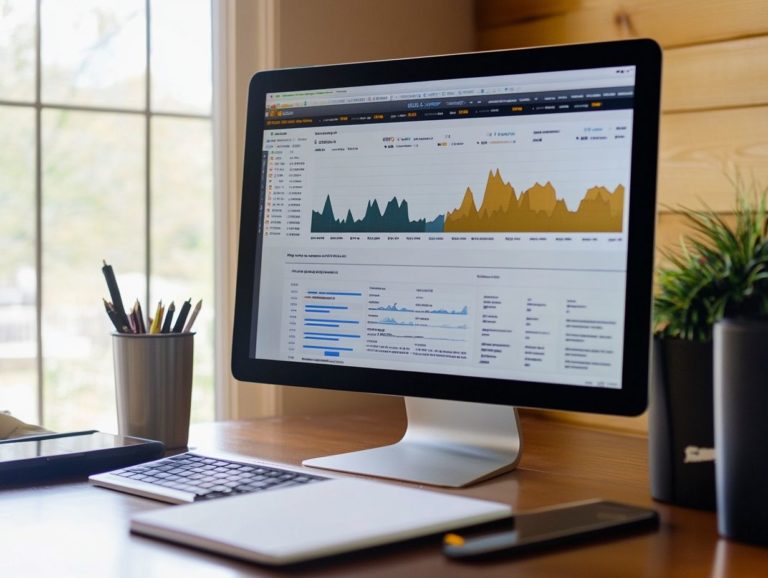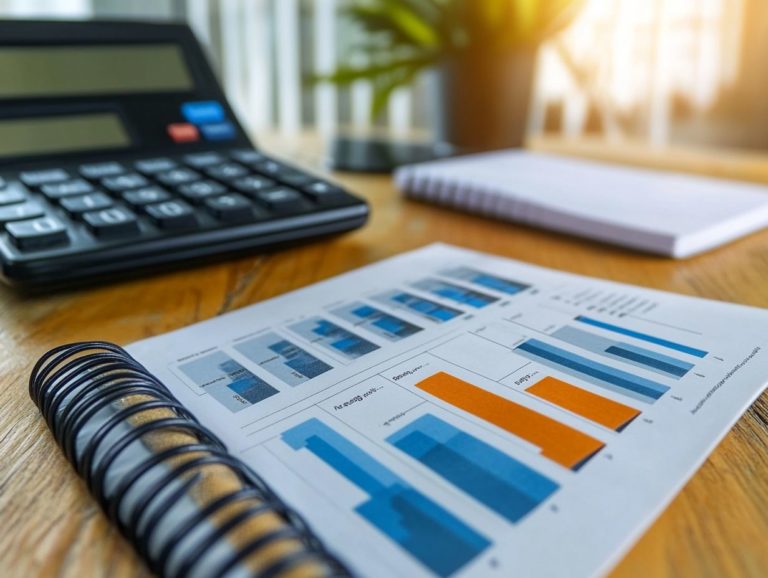the power of predictive metrics in reporting
Predictive metrics are revolutionizing how you approach reporting. They transform raw data into actionable insights that can drive your business forward.
By using these tools, you can enhance both accuracy and efficiency. This empowers you to make informed decisions with confidence.
Let’s explore why predictive metrics are game-changers for your business! This article covers their definition, significance, benefits, and types, including leading and lagging indicators.
This approach is vital in healthcare, where predictive analytics informs patient care decisions. In finance, it helps assess risk and detect fraud.
Dive in to uncover how predictive metrics can truly empower your organization!
Contents
- Key Takeaways:
- Understanding Predictive Metrics
- Benefits of Using Predictive Metrics in Reporting
- Types of Predictive Metrics
- How to Incorporate Predictive Metrics into Reporting
- Challenges and Limitations of Predictive Metrics
- Future of Predictive Metrics in Reporting
- Frequently Asked Questions
- What are predictive metrics and how do they work in reporting?
- Why are predictive metrics powerful in reporting?
- What types of predictive metrics are commonly used in reporting?
- How are predictive metrics different from traditional reporting metrics?
- What are some tips for effectively using predictive metrics in reporting?
- Can predictive metrics be applied to all industries and businesses?
Key Takeaways:

Predictive metrics are important data points that help businesses make informed decisions and improve performance. Incorporating predictive metrics into reporting can lead to improved accuracy and efficiency, helping businesses stay ahead of the competition.
While predictive metrics have many benefits, businesses must also be aware of possible biases and limitations when using them in their reporting.
Understanding Predictive Metrics
Understanding predictive metrics is crucial if you’re looking to elevate your organization s decision-making through data analytics. By harnessing historical data, you can use predictive analytics to anticipate trends and customer behaviors.
This enables you to make informed decisions that foster growth. The synergy of statistical modeling and machine learning techniques helps refine your predictive models, enhancing accuracy in pinpointing potential risks and optimizing resource allocation.
Definition and Importance
Predictive analytics involves techniques to analyze historical data to forecast future outcomes. This plays an essential role in strategic decision-making.
By leveraging statistical methods like regression analysis and time series forecasting, you uncover patterns that might have eluded your attention. This approach is vital in fields such as healthcare and finance.
For instance, imagine using predictive models to forecast patient admission rates during flu season. This foresight enables you to prepare your staff and resources effectively.
Benefits of Using Predictive Metrics in Reporting
Unlock vital benefits now by leveraging predictive metrics in your reporting! This approach enhances the accuracy of your forecasts and streamlines processes, leading to improved customer retention and satisfaction.
Improved Accuracy and Efficiency
Improved accuracy and efficiency are key advantages of implementing predictive models. They enable you to make precise forecasts and optimize resources effectively.
By harnessing advanced algorithms and data analytics, you can anticipate market shifts and consumer behavior, enhancing your decision-making process.
For example, Amazon uses predictive analytics to forecast inventory needs, ensuring popular items are always available while minimizing overstock. This boosts customer satisfaction and cuts carrying costs.
General Electric employs predictive maintenance models for their machinery, leading to a remarkable 10-15% reduction in maintenance costs and increased equipment uptime.
These examples demonstrate how embracing predictive models can revolutionize operational efficiency and drive profitability.
Types of Predictive Metrics

Predictive metrics can be classified into two main categories: leading and lagging indicators. Leading indicators predict future performance, while lagging indicators reflect past performance.
Understanding this distinction allows you to leverage these metrics effectively in your analysis.
In conclusion, implement predictive metrics in your business now to drive informed decision-making and enhance performance!
Leading vs. Lagging Indicators
Leading indicators signal future performance. Lagging indicators reflect past outcomes. Both are essential for effective predictive analytics.
Understanding these indicators is crucial for your business as you navigate market dynamics.
For instance, leading indicators like new customer inquiries or increased website traffic can hint at a potential uptick in sales. This enables proactive marketing strategies. Conversely, lagging indicators, such as quarterly revenues and customer retention rates, provide insights into past performance, allowing you to assess recent initiatives.
By analyzing both types, you can craft informed strategies that align with current trends and historical performance. This ultimately enhances your decision-making processes.
How to Incorporate Predictive Metrics into Reporting
This approach will significantly improve your decision-making processes, helping you handle challenges confidently.
Incorporating predictive metrics into your reporting requires a commitment to best practices and the use of sophisticated predictive analytics tools.
Best Practices and Tools
Utilizing best practices and harnessing predictive analytics tools, such as H2O.ai and Google Cloud, can greatly enhance the effectiveness of your predictive metrics in reporting. This enhancement is essential for organizations that seek deeper insights into operations and aim to make informed, data-driven decisions.
To achieve optimal results, focus on specific best practices, particularly in data integration. By consolidating disparate data sources, you ensure a comprehensive view that informs your strategies. Rigorous model validation processes help identify potential biases and inaccuracies, leading to more reliable outcomes.
Implementing continuous improvement strategies like regularly updating models and incorporating user feedback is vital for keeping your analytics relevant. Ultimately, using machine learning where computers learn from data refines your predictive analytics applications, enabling your business to adapt swiftly to market changes.
Challenges and Limitations of Predictive Metrics
While predictive metrics offer significant advantages, they also have challenges and limitations.
Data biases can greatly influence your predictive metrics. This impact can lead to flawed interpretations in statistical modeling. It’s essential to remain vigilant and critically assess the data to ensure reliable insights.
Possible Data Biases and Other Factors

Data biases can significantly impact your predictive metrics, leading to flawed interpretations and erroneous conclusions in your statistical modeling.
These biases can skew your results, affecting your decision-making processes across various sectors, from healthcare to finance. For example, if your historical data overlooks minority populations, it may lead to predictions that fail to account for their unique needs.
You must act now to combat these issues. Here are some effective strategies:
- Diversify your data sources.
- Regularly audit your datasets for bias.
- Utilize advanced algorithms specifically designed to identify and correct these discrepancies.
By actively addressing potential biases, you can enhance the reliability and accuracy of your predictive metrics, ensuring more equitable outcomes and knowledge-based decision-making.
Future of Predictive Metrics in Reporting
Get ready! The future of predictive metrics in reporting is bursting with potential, driven by emerging trends in predictive analytics and cutting-edge advancements in machine learning technologies.
Emerging Trends and Technologies
Emerging trends in predictive analytics, particularly in machine learning and advanced analytics, are set to transform how businesses leverage predictive metrics. This change is driven by robust technologies like Apache Spark and FICO, which enable quick and efficient processing of large datasets.
In healthcare, organizations are using these tools to improve patient outcomes through predictive modeling, which predicts health issues before they arise.
In the financial services sector, predictive analytics enhances risk management and fraud detection, allowing institutions to make informed decisions based on real-time data. Various industries are adopting these advanced technologies, revealing an exciting potential to streamline operations while minimizing risks.
Frequently Asked Questions
What are predictive metrics and how do they work in reporting?
Predictive metrics are quantitative measures used to forecast future trends, patterns, and outcomes. In reporting, they analyze past data to predict future performance.
Why are predictive metrics powerful in reporting?

Predictive metrics provide valuable insights, helping businesses make informed choices. By forecasting future trends, they can identify risks and opportunities, leading to better performance and profitability.
What types of predictive metrics are commonly used in reporting?
Common types of predictive metrics include financial, operational, and customer-related metrics. Examples are revenue growth, customer churn rate, and inventory turnover.
How are predictive metrics different from traditional reporting metrics?
Traditional reporting metrics focus on past performance, while predictive metrics analyze historical data to forecast future outcomes. This approach allows businesses to proactively address potential issues and make data-driven decisions.
What are some tips for effectively using predictive metrics in reporting?
To use predictive metrics effectively, businesses should ensure their data is accurate and current, select metrics that align with their goals, and regularly review and analyze data to adjust strategies as needed.
Can predictive metrics be applied to all industries and businesses?
Yes, predictive metrics can be applied to nearly any industry or business, provided there is sufficient historical data for accurate predictions. However, the specific metrics used may vary depending on the industry and business goals.






